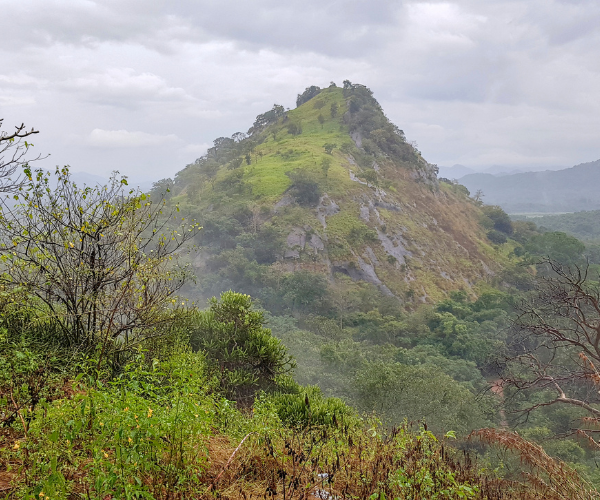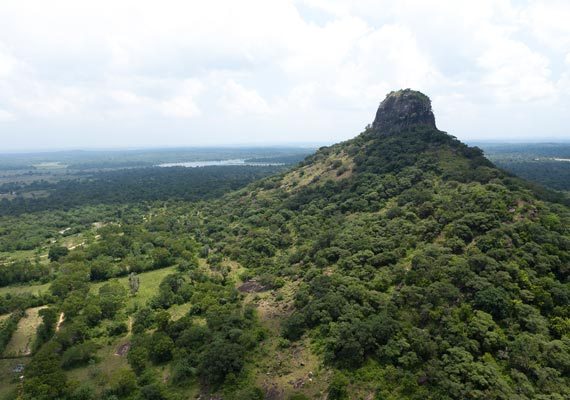Thoppigala – spectacular archetypal inselberg – By Arundathie Abeysinghe
Image Source : dilmahtea
 The highest peak located between *Dimbulagala near *Polonnaruwa and the East Coast situated 543 meters above sea level, the inselberg “Thoppigala” (in Sinhala) and “Kudumbimalai” (in Tamil) meaning “hair-knot” rock is surrounded by protected dry zone scrub jungle within an area of 400 square kilometers. The nearest village Manamptiya situated approximately 14 kilometers away from Thoppigala was developed due to the Mahaweli Irrigation Scheme. Thoppigala is also part of the traditional *Veddah community situated in the vicinity of the Maduru Oya National Park abundant with large herds of deer, elephants and leopards that are roaming in the wilderness between Thoppigala and Maduru Oya. This rocky edged mountain was also known as “Piyagalaka Agali Pawatha” in the past.
The highest peak located between *Dimbulagala near *Polonnaruwa and the East Coast situated 543 meters above sea level, the inselberg “Thoppigala” (in Sinhala) and “Kudumbimalai” (in Tamil) meaning “hair-knot” rock is surrounded by protected dry zone scrub jungle within an area of 400 square kilometers. The nearest village Manamptiya situated approximately 14 kilometers away from Thoppigala was developed due to the Mahaweli Irrigation Scheme. Thoppigala is also part of the traditional *Veddah community situated in the vicinity of the Maduru Oya National Park abundant with large herds of deer, elephants and leopards that are roaming in the wilderness between Thoppigala and Maduru Oya. This rocky edged mountain was also known as “Piyagalaka Agali Pawatha” in the past.
The British had called this enormous spectacular monadnock as “Baron’s Cap” (during the British Colonial Era) due its distinctive shape of a hat.
Situated approximately 40 kilometers away from *Batticaloa, amidst a thick jungle, Thoppigala had played many significant roles in Sri Lanka’s history. According to archaeologists, the rocky mountain and the surrounding jungle had been the venue of a huge monastery constructed during the *Anuradhapura era. There are diverse stone inscriptions on different locations of the mountain with descriptions of donations by King Kaniththatissa (165-193) to the monastery complex. According to an expedition carried out in 1983 by prominent scholars, there had been remains of a huge stupa (dagoba) in Thoppigala.
Scholars are of the view that centuries ago, the location has been the dwelling site of *Arhats.
During recent years, Thoppigala became well-known due to the “Battle of Thoppigala”, a major battle between Sri Lanka Army and the Liberation Tigers of Tamil Eelam (LTTE) fought during 2007 over control of the LTTE-dominated peak of Thoppigala. Due to the three-decade civil war that took place between Sri Lanka Army and LTTE that engulfed the Eastern and Northern Provinces of Sri Lanka (since early 1980s), archeological research could not be carried out in the location.
Thoppigala is also a location with geostrategic significance due to the formation of the rock surrounded by broad plains, rivers, tanks as well as thick jungle. From the summit of the Rock, the surrounding area could be seen for kilometers, an advantage for those occupying the location as invading armies from the valleys could be easily seen.
During the three-decade long war against LTTE terrorists, Thoppigala played a significant role. Surrounded by rocky terrain and thick jungle the mountain was an ideal location to wage guerrilla warfare. Thoppigala has also been utilized by the LTTE as a base camp from which they launched attacks on Sinhalese villages in the surrounding area, thereby, ethnically cleansing old villages and its population. In 2007, the LTTE camp in the location was captured by the Army.
Thoppigala has played diverse stages in history; a dwelling site of Arhats, a camp site of the LTTE, a battle ground between the Army and the LTTE, a nature lovers’ paradise as well as a biodiversity hotspot with the surrounding jungle and wildlife (at present).

Declared open in April 2013, Thoppigala Heritage Park situated within the location is a nature conservation project launched by Dilmah Conservation, with the assistance of the Forest Department and Sri Lanka Army. The Heritage Park also comprises the Thoppigala Memorial, dedicated to the lives lost during the battle of Sri Lankan armed forces against LTTE guerilla camp in the Eastern Province. The war memorial constructed at the location commemorates the Army’s victory over the LTTE. The exhibition area features diverse stages of the Civil War; photographs, models and display units showcase the significant role played by the Sri Lanka Army during the war.
- Anuradhapura – A major city in Sri Lanka (former Ceylon), the capital of Anuradhapura District. Anuradhapura was one of the ancient capitals of Sri Lanka and is famous for its well-preserved ruins of Sri Lankan civilization. Founded in the 4th century, Anuradhapura was the capital of Sri Lanka until the beginning of the 11th century. Anuradhapura is considered sacred to Buddhists and there are monasteries, stupas within an area of 40 square kilometers. Anuradhapura was declared as the “Sacred City of Anuradhapura” and a World Heritage Site by UNESCO, in 1982.
- Arhat – According to Buddhism, an Arhat is one who has gained insight into the true nature of existence and achieved *Nirvana.
- Batticaloa – A major town and commercial center in the Eastern Province of Sri Lanka. Batticaloa is located on land between the lagoon and the Indian Ocean. Batticaloa District is flourished with three lagoons: Batticaloa Lagoon, Valaichchenai Lagoon and Vakari Lagoon.
- Brahmi inscriptions – The earliest writing system developed in India after the Indus script and considered as an influential writing system. All modern Indian scripts as well as several hundred scripts that are in South Asia, Southeast and East Asia are derived from Brahmi.
- Chola conquest – This was a military invasion of the Anuradhapura Kingdom by the Chola Empire of Southern India, one of the longest ruling dynasties in world history. Initially, the Anuradhapura Kingdom was invaded in 993 AD and absorbed into the Chola Empire of Southern India.
- Dimbulagala – Also known as “Gunner’s Quoin” or “Gunner’s Rock” during the British Colonial Era, this is a rock formation located in the *Polonnaruwa District. According to historical records, when anthropologist Charles Gabriel Seligman visited the location in 1911, a cave within the rock had become a refuge of the indigenous *Veddas. During the 12th century AD, Sinhalese people in the hamlet had constructed a Buddhist Monastery within the rock formation known as “Dimbulagala Raja Maha Viharaya”. Dimbulagala range houses several caves cut into the rock with *Brahmi inscriptions over the drip ledges. Home to some of the most valued fragments of early frescoes, they were known as the “Gunners Quoin” by the British. The Buddhist monastery had been abandoned after the period of the Kingdom of Polonnaruwa. It was restored to the current status in the 1950s due to the efforts of late Venerable Kithalagama Sri Seelalankara Thera, the chief incumbent until he passed away in 1995. The villagers dwelling in the rock are of mixed Sinhalese ancestry and Vedda
- Nirvana – Refers to a release from the cycle of death and rebirth, the ultimate spiritual goal of Buddhism.
- Polonnaruwa – The Kingdom of Polonnaruwa or the ancient city of Polonnaruwa (also known as “Pulastipura”) was the second capital of Sri Lanka for three centuries from 11th to 13th centuries. After the *Chola conquest of the Anuradhapura Kingdom, the center of administration was shifted to Polonnaruwa, until 1232. Polonnaruwa has been declared a World Heritage Site by UNESCO.
- Veddas – Also spelled as “Veddah” and known as “Wanniyalaeto” are a minority indigenous group of people in Sri Lanka. Considered as Sri Lanka’s aboriginal inhabitants prior to the 6th century bce, according to historical records, they were the children or descendants of Queen Kuweni, a *Yaksha and the wife of Sri Lanka’s legendary first King Vijay (5th BC). Anthropologists date them to the Stone Age. Predominantly, hunter-gather people, the Veddas have been living harmoniously with nature.
- Yaksha – Yaksha (in Sanskrit) and Yakkha (in Pali) are considered as a broad class of nature-spirits, usually benevolent, yet sometimes mischievous or capricious. They appear in Buddhist, Hindu as well as Jain texts. These spirits are linked with water, fertility, trees, forest, treasure and wilderness in ancient and medieval era temples of South Asia and Southeast Asia. They are considered as guardian deities. The feminine form of “Yaksha” is “Yakṣī” or “Yakshini” (in Sanskrit) and Yakkhini (in Pali).








